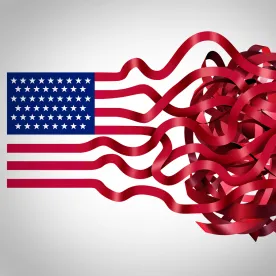Key Takeaways:
-
U.S. prohibits investments in 59 Chinese Military Industrial Companies (NS-CMIC)
-
The prohibition forms part of a larger U.S.-China confrontation that has implications across finance, industry, and even academia.
-
Companies need to understand the geopolitical forces behind trade relations in order to act ahead of regulations rather than being caught in a reactive position.
-
The question for every company, whether an investment fund holding securities in Chinese companies, a startup looking for finance from overseas, or a manufacturer securing its supply chain, is: Where will the U.S.-China confrontation go next, and how do we prepare?
A June 3, 2021 Executive Order (see our post here) designated 59 Chinese companies in which U.S. companies are prohibited from buying or selling securities. According to the Biden administration, those companies “threaten the security or democratic values of the United States and [its] allies.” That statement encapsulates the trend of regulation, in the United States and in China, as the countries confront one another in a struggle for technological dominance.
A full investigation of the roots of this confrontation are beyond the scope of a blog update, but let’s take it as a given that the United States’ goal in the confrontation is to maintain a unipolar technological dominance, supported by its allies. Meanwhile, China’s goal is to attain an economic and political hegemony to rival, and surpass the United States, which would require a technological equality or advantage. As President Biden summarized the situation in his first speech to Congress, America must “repair our alliances and engage with the world once again, not to meet yesterday’s challenges, but today’s and tomorrow’s. American leadership must meet this new moment of advancing authoritarianism, including the growing ambitions of China to rival the United States.”
So the question for every company, whether an investment fund holding securities in Chinese companies, a startup looking for finance from overseas, or a manufacturer securing its supply chain, is:
Where will the U.S.-China confrontation go next, and how do we prepare?
We have been having this discussion with boards of directors, strategy committees, and management teams of our global clients. We have also seen that the trade compliance specialists in the companies are well placed to be a valuable resource in supporting these discussions. The discussions are wider ranging but we’ll take the examples of the NS-CMIC list and the Military End User lists to show how strategic compliance can be achieved through geopolitical analysis.[1]
Lists of Lists
In the past few years the U.S. Government has been producing lists of prohibited and restricted Chinese parties at a tremendous pace. Here we will focus on two similar but distinct lists to illustrate how we move from reacting to regulations to anticipating and preparing for them.
-
Chinese Military Industrial Companies List
This is a list of Chinese companies in which U.S. persons are prohibited from buying or selling securities
-
Military End User List
This is a list of Chinese companies to which the export of U.S.-origin items are severely restricted because the receiving company provides support to the Chinese Military
Ostensibly, the first list only affects investment funds holding or interested in Chinese securities. The second would only affect parties selling to Chinese military end users (which, in light of the China Civil-Military Fusion program, is not a small population of companies).
However, when you extrapolate these measures, it could affect U.S. M&A deals, startups of all sizes, tech companies, software developers, research institutions, universities, non-U.S. companies, and manufacturing of all types.
Looking past the Immediate
The CMIC List directly affects U.S. investors and non-U.S. parties investing through U.S. funds. However, when we step back, we realize that the regulation is not passed in a vacuum. It is likely that China will implement a countermeasure. Imagine if China implements a similar investment ban. That could mean that companies – including non-U.S. companies – that supply the U.S. Government (the world’s largest consumer) may lose access to the hundreds of billions of investment capital that is sloshing around China, looking for a place to land.
The MEU list directly prohibits the export of certain items to Military End Users in China. Step back and look a little more broadly, and you will see that the prohibition also includes restrictions on sharing technology with those MEUs. Additionally, there are dozens, perhaps hundreds of Chinese universities that provide significant support to the Chinese military. That means the MEU list may have effects on U.S. research institutions and universities looking to collaborate with partners in China. It may also scuttle technology research and development joint ventures
Looking up and imagining a countermeasure from China, consider how supply chains – again, including the sourcing for non-U.S. companies – would look if China prohibited exports from China to companies that sold to U.S. that also sold to the U.S. Department of Defense. Especially if the prohibition included sales of commercial items to a company where that company’s military sales were completely unrelated to the commercial transaction.
Conclusions and further discussions
We are not simply ginning up nightmare scenarios to keep compliance and operations leads up at night. We hope to broaden thinking on trade controls so that we can all revamp strategic planning and anticipate changes. The market can adapt to any change in regulations. The companies that can foresee the changes can adapt better and beat the market. That is the discussion we are having, and we invite you to join.
[1] We recognize that “think strategically” is a buzzword that is often thrown out when the speaker does not want to deal with the details of the situation. However we warn you that this is very much a detail-oriented strategy, so apologies in advance if you were not expecting to be dragged into the weeds.






 />i
/>i
